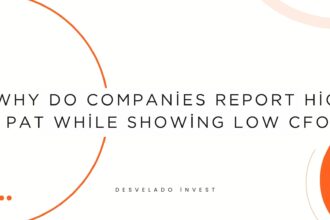Written By: Anika Manav
If you study numerous annual reports, you might notice that many companies report a different Net Profit or Profit After Tax (PAT), in comparison to their Cash Flow from Operations (CFO). There are a few reasons for this difference, and one of them is that they represent slightly different aspects of the company.
Whereas the PAT of the company represents the total earnings that the company had, net of the costs for the year, the CFO depicts the position of the company in terms of only the operating activities.
Generally speaking, when a company calculates its profit (PAT), it deducts certain costs that don’t actually involve cash going out, like the gradual wear and tear of machines (called depreciation) or the spreading out of costs over time (called amortization). However, when calculating CFO, these non-cash costs are added back, which usually makes CFO larger than PAT.
If the case is the opposite, meaning that the PAT is higher than the CFO, this might indicate that some of the cash may be stuck in unpaid bills from customers, unsold inventory, or other business expenses. So, working Capital or the income from sources other than the main operations of the business is unusually high in this case.
This situation can be a warning sign, as it means the company’s profit on paper looks good, but it may not have enough cash available to run its day-to-day operations smoothly.
Let us discuss these and more reasons for this difference through the following example:
Godfrey Philips India Limited (GPIL) showed a Net Profit or PAT of ₹833.9 crore in its Statement of Profit and Loss for the year ended March 31st, 2024. On the other hand, the company reported the CFO to be ₹290.2 crore on its Cash Flow Statement.
Source: Godfrey Philips India Limited Annual Report – FY24, Page – 182
Source: Godfrey Philips India Limited Annual Report – FY24, Page – 184
Now, we will go over some of the reasons for the PAT to be higher than the CFO.
1. Basis of Accounting
The Income Statement follows the Accrual Basis of Accounting, which means that incomes are recorded when they are earned and expenses are recorded when they are incurred, regardless of the cash inflow and outflow.
On the other hand, the Cash Flow Statement uses the Cash Basis of Accounting, which does not take items such as accrued and advance income or prepaid and outstanding expenses. Meaning, this statement is only concerned with the inflow and outflow of cash.
Furthermore, non-cash expenses such as Depreciation, Amortisation, and Impairment are added back to the PAT in the calculation of the CFO to provide an accurate standing of the company based on cash.
In the below extracts from the financial statements of GPIL, we can see that the Depreciation and Amortisation expenses that were subtracted from the revenue in the Income Statement, as part of the Total Expenses, have been added back to the PAT in the Cash Flow Statement.
Source: Godfrey Philips India Limited Annual Report – FY24, Page – 182
Source: Godfrey Philips India Limited Annual Report – FY24, Page – 184
2. Treatment of Non-Operating Items
Next, all income that has not been earned from, and all expenses that have not been incurred by the main operations of the business are subtracted from or added to the PAT to calculate the CFO.
These items can be Interest Received or Paid, Divided Received or Paid, Profit or Loss from the Sale of Assets, and Proceeds or Repayment of Debt. These items are then adjusted further in the Cash Flow Statement under Cash Flow from Investing Activities or Cash Flow from Financial Activities. This ensures that the CFO represents all the cash transactions related to the business operations.
We can see this treatment in the Note to Accounts of the Income Statement and on the Cash Flow Statement.
Source: Godfrey Philips India Limited Annual Report – FY24, Page – 221
Source: Godfrey Philips India Limited Annual Report – FY24, Page – 222
Source: Godfrey Philips India Limited Annual Report – FY24, Page – 184
3. Changes in Working Capital
Finally, the increases or decreases in the Working Capital are incorporated in the Cash Flow Statement. Any increase in the current assets or decrease in current liabilities is subtracted, as an increase in the Working Capital shows a cash outflow and vice versa.
In the extract of the Cash Flow Statement of GPIL, we can see that they have incorporated these changes.
Source: Godfrey Philips India Limited Annual Report – FY24, Page – 184
Now that we have found the reasons for the PAT of a company to be reported higher than the CFO, let us understand the possible interpretations of this.
There can be negative or positive reasons for the company to have a CFO which is less than the PAT. Some positive reasons can be, an increase in investments in current assets, or paying off some current liabilities. Another could be that the company is in its growth stage and a good part of its profit is generated from financing or investing activities.
However, the last point can also be considered a negative aspect for a company that has passed its growth stage, as it would imply that the company is not generating comparatively enough revenue through its main operations.
In short, Analysts should study both statements and find out the biggest reasons for the differences, then go on to determine if those reasons are affecting the company positively or negatively.






